
While people are hunkered down in their homes, waiting for the novel coronavirus to halt its spread, some hopeful news about marine health has emerged.
In the midst of sheltering in place, ocean health may not be top of mind for most. Nevertheless, in order for ocean life to survive and even thrive, society needs to tackle several challenges, including global warming, plastic pollution and unsustainable fishing.
In this time of global health obstacles and environmental challenges, some hopeful news goes a long way, especially as ocean temperatures continue rising and scientists project regular global coral bleaching. Today, hope comes in the form of a study published in Nature on April 1, which contends that marine health can be restored by 2050 - and shows exactly how.
"We are at a point where we can choose between a legacy of a resilient and vibrant ocean or an irreversibly disrupted ocean," Carlos Duarte, a marine ecology researcher, told Phys.org. "Our study documents recovery of marine populations, habitats and ecosystems following past conservation interventions. It provides specific, evidence-based recommendations to scale proven solutions globally.”
Human action can make a difference for marine health
The study — a collaboration between marine scientists across 10 counties and 16 universities — not only calls out areas for improvement; it also identifies the benefits oceans have reaped due to human action and nature’s innate resilience.
“A lot of us, recently, have seen signs of hope,” Boris Worm, a marine ecologist at Nova Scotia’s Dalhousie University, told The Globe and Mail. “Not to say that the world is getting better wholesale. But there are now hundreds and hundreds of examples that when we do something, the ocean displays remarkable resilience.”
These “signs of hope” for marine health worldwide are worth calling out.
First, less than 1 percent of the world’s oceans had some form of legal protection in 2000. Now, almost 8 percent is protected. Evidence also indicates that commercial fishing is not as detrimental to wildlife as it once was, and fertilizer and sewage pollution are diminishing. Finally, nearly half of the 124 marine mammal species populations are increasing.
“Even habitat loss is less prevalent than it was before,” Dr. Worm said. He points to myriad examples of local actions that have led to local results.
Action at many levels is still needed to protect oceans
These signposts on the path to restoration are a helpful reminder that coordinated action makes a difference. In an effort to refine and encourage global endeavors, study authors identify how to act and where.
A comprehensive review of ocean conservation efforts revealed the ecosystems and elements essential to whole-ocean recovery. Such habitats include salt marshes, mangroves, seagrasses, coral reefs, kelp, oyster reefs, fisheries, megafauna and the deep sea. Within each of these bite-size components, conservationists can concentrate efforts using various interventions.
The Nature study describes these steps as complementary “recovery wedges,” and they include the protection of vulnerable habitats and species; harvesting resources with caution; launching marine health efforts starting with the restoration of important habitats; a focus on reducing pollution; and finally, mitigating climate change.
Recovery wedges are meant to be used together, or in other words, “stacked.” The report identifies specific wedges to activate within key ecosystems and environments.
While all of these recovery wedges are critical, climate change is priority number one. “If we don't tackle climate change and raise the ambition and immediacy of these efforts, we risk wasting our efforts," Professor Duarte told BBC. Duarte also mentioned overfishing and plastic pollution as significant elements. While single-use plastics have become useful, even essential, during this pandemic, plastic pollution in the ocean remains a serious issue.
What would wholesale restoration cost? The study puts the expense for sustained ocean health at $10 to 20 billion per year, plus more for restoration. If that seems overpriced, consider that the authors foresee a $10 return for every $1 invested in such restorative efforts, and more than a million new jobs.
The ocean already contributes 2.5 percent of global GDP — through ecosystem services, food, recreation and more — and employs 1.5 percent of the global workforce. That adds up to an estimated $1.5 trillion generated in 2010, and double that amount by 2030. This investment just makes sense — it’s tried and true.
"Rebuilding marine life represents a doable grand challenge for humanity, an ethical obligation and a smart economic objective to achieve a sustainable future," Susana Agusti, a professor of marine science, told Phys.org.
Image credit: Keith Luke/Unsplash

Roya Sabri is a writer and graphic designer based in Illinois. She writes about the circular economy, advancements in CSR, the environment and equity. As a freelancer, she has worked on communications for nonprofits and multinational organizations. Find her on LinkedIn.














